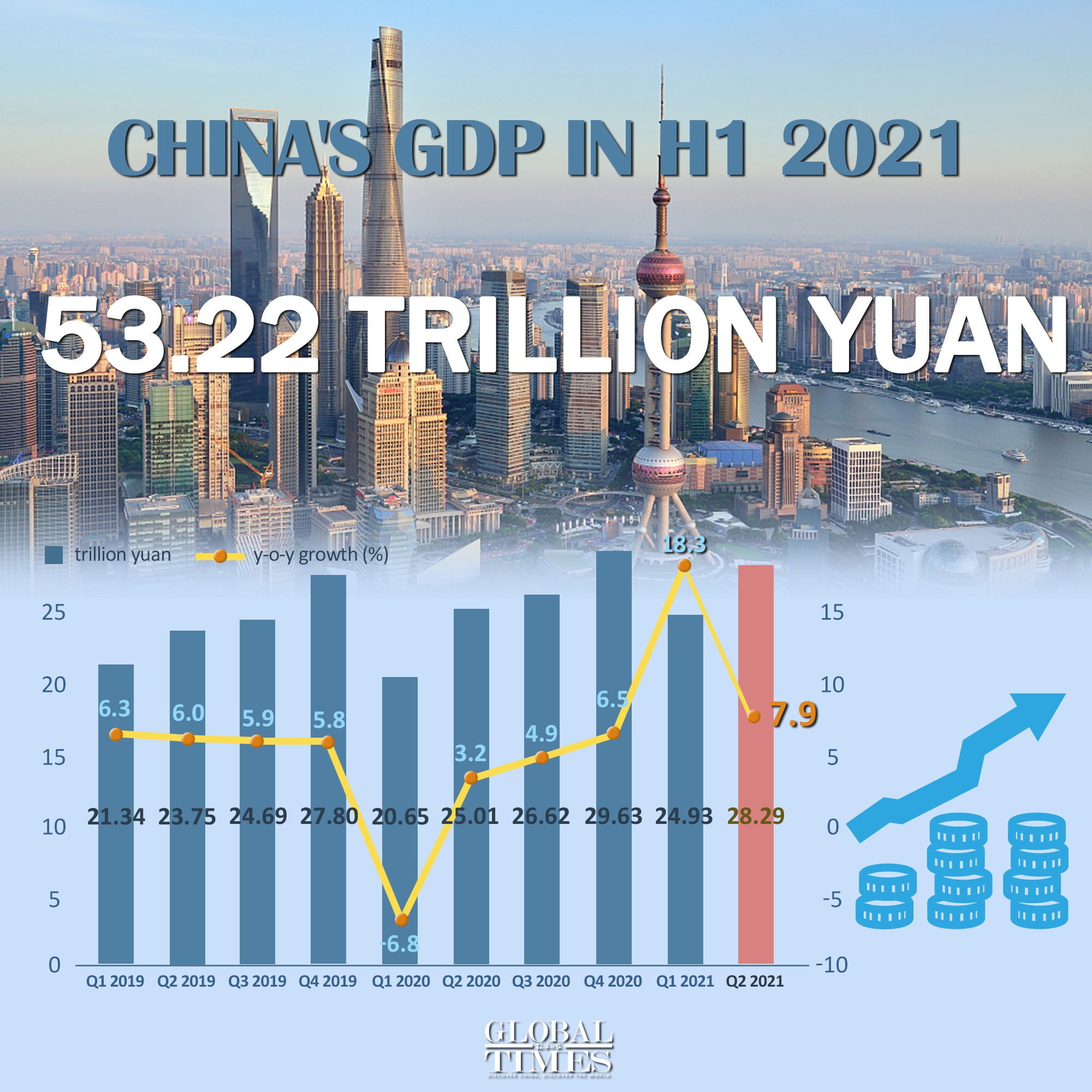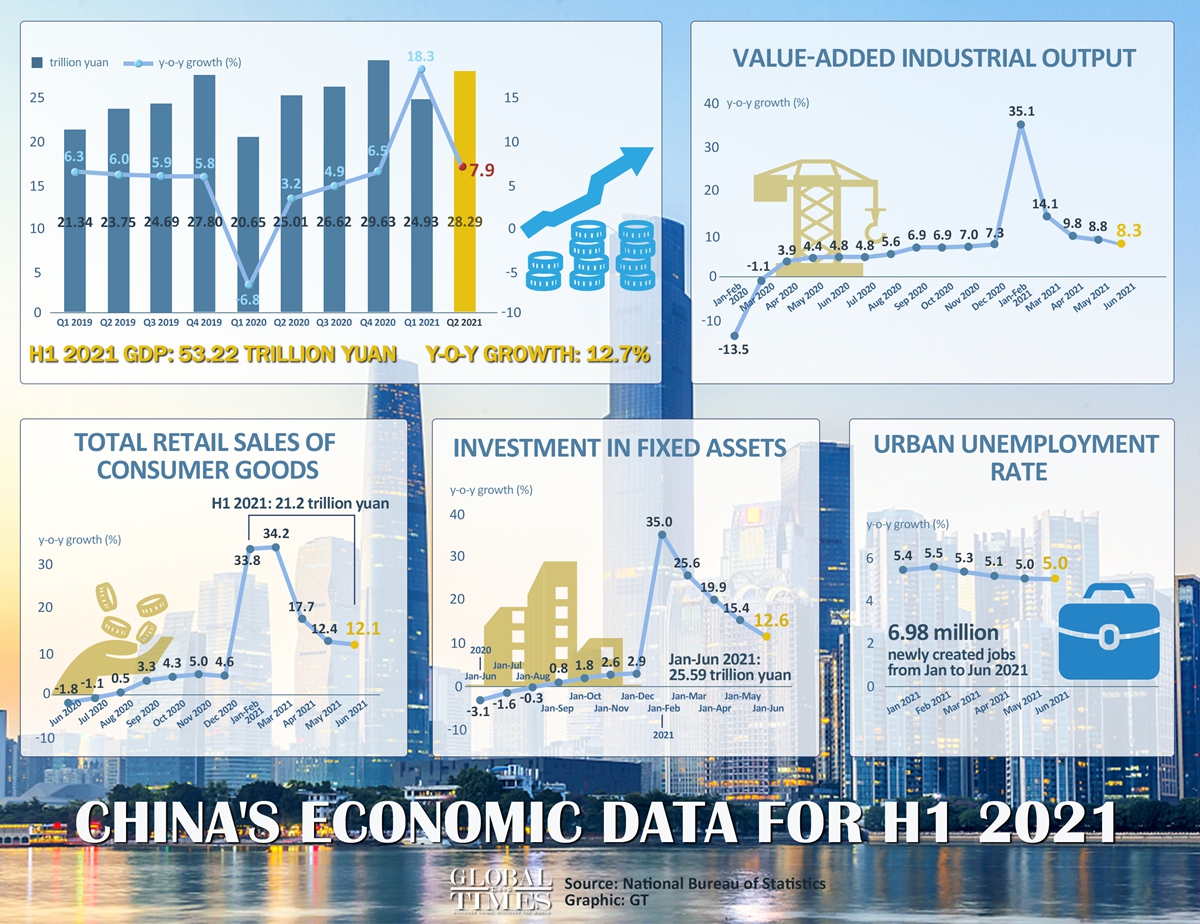
Infographic: GT
China's GDP expanded 7.9 percent year-over-year in the second quarter of 2021, continuing a streak of robust growth mainly thanks to the government's successful containment of the COVID-19 outbreak throughout the country, which sets the basis for a steady revival of domestic consumption and manufacturing activity.
The growth rate offers another signal that China's economy has emerged from the coronavirus fallout and returned to pre-virus levels.
But the economy is likely to face rising downward pressure in the second half, as global price hikes for raw materials and supply bottlenecks, semiconductor chips in particular, could continue unabated, and weigh on manufacturers and consumers alike, while a flare-up of the coronavirus outbreaks overseas will cast a shadow on the economy.
In the first six months, China's GDP gained 12.7 percent year-on-year to 53.2 trillion yuan ($8.22 trillion), said the National Bureau of Statistics (NBS) on Thursday. In the first quarter, China's economy expanded 18.3 percent, the fastest pace since the data began to be recorded in 1993.
In the April-June period, factory output rose 8.9 percent year-on-year while retail sales were up 13.9 percent, according to the NBS.
"China's economic recovery is brisk and very healthy, as although the government has put a lot of resources on stimulating the economy, it is also making sure that economic development is balanced, able to be sustained, and there wasn't a flood of liquidity," Hu Qimu, chief research fellow at the Sinosteel Economic Research Institute, told the Global Times.

Infographic: GT
"China's economic recovery is a high-quality revival, as it has eliminated some redundant, inefficient capacity and changed the nation's overall industrial structure for the better," Hu said.
Exports remained one of the biggest drivers of the Chinese economy in the second quarter. Hu said that the steady flow of overseas orders to China provided a strong support for the economy.
"The key to the second quarter rosy data was China's successful control of COVID-19, which boosted Chinese companies' confidence and motivated them to make a transition from external markets to internal markets," Dong Dengxin, director of the Finance and Securities Institute of Wuhan University, told the Global Times.
Despite several sporadic coronavirus outbreaks, analysts said that China's nationwide vaccination plan had largely restored consumers' confidence and helped factories operate in a steady manner.
China's financial policy makers have been supportive of a robust economic recovery, including the extension of some favorable policies meted out in 2020, and the roll-out of new policies after the "two sessions" in March to support small and micro-size businesses.
In the second half of 2021, economic growth will soften from the first half -- a result of lesser base effect from last year -- but the economy can still manage to grow at 8 percent for the whole year, which analysts said would be a "good recovery."
Nomura economists led by Lu Ting said in a note sent to the Global Times that their forecast for China's GDP growth is to slow to 6.4 percent in the third quarter and 5.3 percent in the fourth quarter.
Dong said that external risks, such as heightened inflation in the US and resurging COVID-19 in Asia and Europe, might flare in the second half which might shadow the world's second largest economy.
Another challenge China faces is that domestic consumption has not yet recovered to pre-pandemic levels. "If manufacturing is coming back at its full force but home consumption continues to lag behind, inventory will go up, and enterprises are likely to face liquidity problems," Hu noted.
The Chinese government has been leveraging policy tools to keep the economy from losing steam.
Recently, the central bank lowered the reserve requirement ratio of commercial lenders by 50 percentage points, firing up the economy with adequate liquidity and preventing a possible slowdown. The cut took effect on Thursday.
"The policy signal sent by the central bank is clear, but whether the effect is as good as expected depends on what action the lenders take -- like whether they will channel more money to the real economy by lending more to middle and small-size enterprises which need a credit line most," Dong said.
According to Dong, the central bank will keep a close watch on the effect of the reserve ratio cut, and might make another cut before the end of this year. Other measures to spur consumption could also be worked out in the second half, analysts said.
Beijing sets an annual economic growth target at above 6 percent for 2021.



